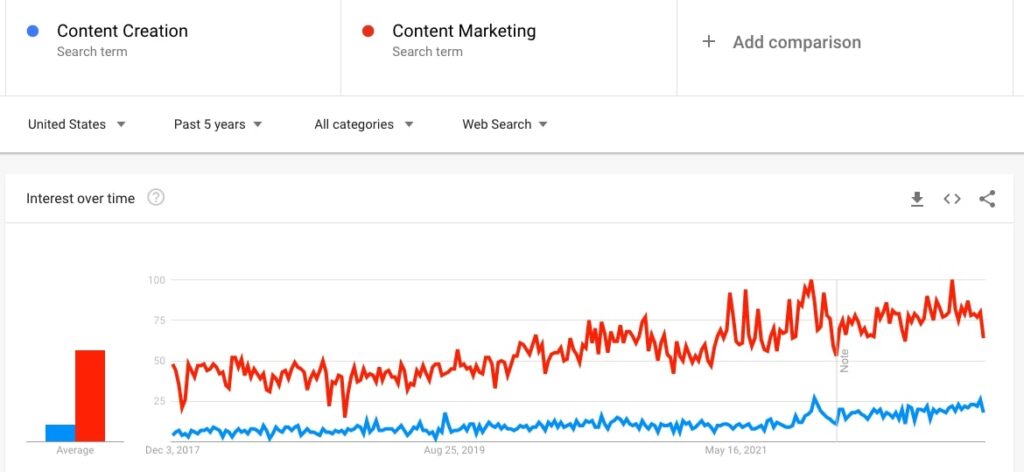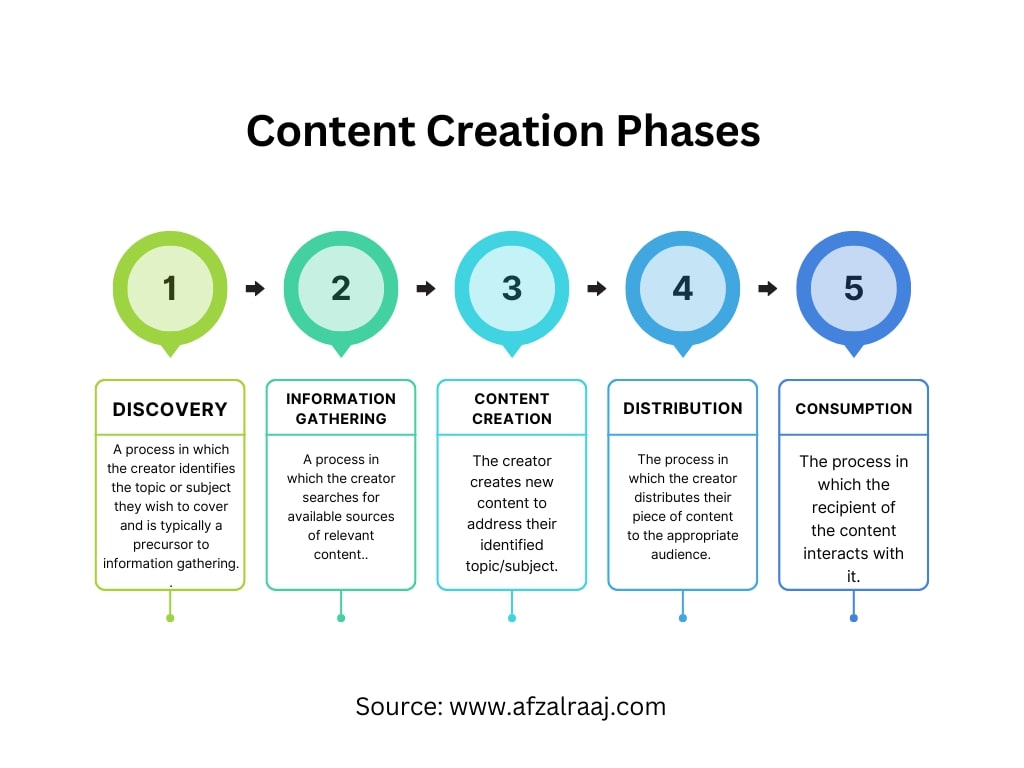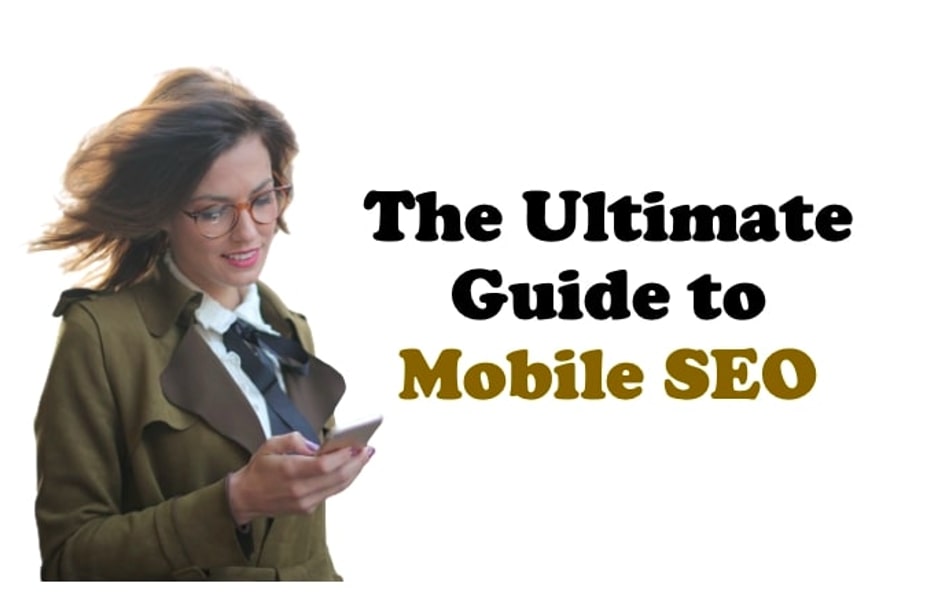Content creation is a process that helps in the development of Content. It involves creating high-quality Content relevant to the needs and wants of the target audience. A content hub model is the best way to create and publish Content on the website.
In other words, Content creation turns raw materials, such as text, images, audio, and video, into the Content published on a website. Without a doubt, content is king, and no one can deny its importance.
Content creation can be done in many ways. One person or a group of experts in Contentield can do it. They can also be done by machines designed to create Content automatically or by AI writers like those found on artificial intelligence platforms.
Quick Links
What is Content?
Content can be defined as anything produced to be consumed by an audience. For example, the content could be a blog post on your company website or a podcast you produce for your listeners.
In other words, content is a digital asset that includes text, images, videos, audio recordings, etc. It is created to be consumed by an audience.
Content is the most important part of your website or blog. It is your online identity, and if you want to be successful in the digital world, you need a good content strategy. There are different types of content that you can use on your website or blog:
Textual Content
This content is text-based. You can make it as long or short as you want, but the main idea is to create a textual piece that people can read and understand them.
In order words, Textual content is a term that refers to the written word. It is a kind of content that humans can read and understand.
The textual content can be classified into two types: plain and rich. Plain text is written words without any formatting, while rich text has formatting like bold, italics, underlining, etc.
This content includes articles, blog posts, press releases, and more.
It’s also important that your textual pieces are unique and have a well-written structure with proper grammar and punctuation.
Audio Content
Any form of media that can be listened to is referred to as audio content.
In other words, audio content is creating and delivering spoken, sung, or instrumental audio recordings. Audio content can be delivered on a radio station, podcast, or app.
The content creation process for audio starts with sound recording and editing. The recording is done using a microphone or other sound-capture devices such as an iPhone or computer.
Next, editing is done using software such as Audacity to manipulate the recorded sound according to the desired effects and style of the recording.
The final product is then uploaded to a hosting service like SoundCloud or Apple Music, where it can be listened to by others.
Visual Content
This content includes an image or video and is used to create a visual piece. You can think of this as a small photo or video with some text.
Visual content is a type of content that can be seen and experienced by the senses. It is made up of images, videos, graphics, and illustrations.
Visual content is a type of content that can be seen and experienced by the senses. It is made up of images, videos, graphics, and illustrations.
Visual content can also be called digital media or digital media content. Visual content comes in all shapes and sizes, from infographics to animations to interactive maps.
Visual content is an important part of a website or blog. It can help you catch the attention of your audience, and it can also be used as a tool to sell your product.
The more visual content you have on your site, the more likely people will visit it, share it, and engage with it.
Therefore, when creating visual content for marketing purposes, you should consider what images are relevant to your target audience.
Interactive Content
This is the most modern and new format of content. It may include video games, virtual and augmented reality, interactive advertisements, and similar tech-driven content that draws on the latest in game design and technology.
Video Games: They are a popular form of entertainment, but they are not just for fun. They can also be used as a tool to teach and educate people.
Virtual Reality: The future of content creation is virtual reality. It is a new way of telling stories that have the potential to change the way we communicate with each other.
Virtual Reality (VR) is a computer-generated experience in which users can interact with and explore a three-dimensional, immersive environment that can be either realistic or abstract.
Augmented reality: The content creation industry is undergoing a major shift. The traditional way of writing and publishing has been replaced with augmented reality, where the writer is not just limited to creating content on paper but can also create it in the real world.
The Era of Content Explosion
Content can be defined as anything and everything written or displayed for the audience. It could be a blog post, an article, a book, or even a tweet. Content can come in many forms, but the most common types of content are text-based and visual.
Content has been around for centuries, but its popularity has recently skyrocketed. There are many reasons for this surge in popularity:
– The internet makes it easy to share content with the world
– Blog writing has been considered now a respectable profession
– Social media marketing like Facebook and Twitter make it easy to share content with people who you know
– Google’s search algorithm gives more emphasis on quality content over quantity
– Content marketing became a mainstream practice
Content is everywhere and can be found on the internet, television, radio, print, social media platforms, and even in conversations. In the last five years, content creation and marketing terms have become an upward graph in Google searches because people are now more interested in the content-oriented industry.

How to Create Content?
Content creation is essential for the success of any business. The internet has made it easier to create and share valuable content with your target audience.
There are many ways to approach content marketing, such as blogging, social media, video marketing, and more. What’s important is to create a strategy that works for your business and stick to it.
A)- In-House Team Building
Content creation is a skill that every business needs to have. It helps them to make their brand more recognizable, increase the number of followers, and improve the overall quality of their content.
The in-house team-building process is where the company hires professional writers to assist with content creation.
This usually happens when there is a need for more content and there is a need for constant flow.
They must determine what works best regarding communication, collaboration tools, and workflows.
A lot of time is wasted on formatting and design tasks, so it’s important to figure out what can be done by someone other than the writer.
One of the key reasons companies hire an in-house content creator is to ensure their public image remains positive.
Pros
– The company’s public image remains positive.
– Close monitoring and customizations are possible.
– Brainstorming would be more convenient
Cons
– High cost of acquiring talent, high cost of training
– Limited hiring and firing power
– Operational Cost
B)- Approach Freelancers
Some companies use this process as part of their strategy for scaling up their content production by outsourcing some work or hiring freelancers temporarily.
Many businesses now turn to freelancers to create content for their websites and social media.
This is because they don’t have the time or resources to invest in content creation. Freelancers are also a great option for businesses that need to produce a lot of content but don’t want to invest in full-time staff.
As the world of digital marketing continues to evolve, content creators have become a commodity.
It is not enough for a business to have content anymore; they need great content that aligns with your goals.
Freelancers are paid to create great content, but how can you ensure you’re hiring the right people?
Content creation is critical to any successful website and relies heavily on freelancers. However, this reliance on freelancers can be dangerous if not executed properly.
Pros:
– Cheaper and Task Based Payments
– Convenient to hire and fire
– Reduce operational cost
Cons:
– Communication gape
– Time-consuming
C)- Approach a Professional Agency
To create content that will stand out, you need to hire a professional agency. They use their expert knowledge and experience in the industry to create content that will be successful for your brand.
Companies must use online marketing to promote their products and services. Online marketing is one of the most cost-effective ways for companies to communicate their message.
A professional agency can help reach your target audience with relevant content tailored specifically for them.
Hiring an agency to create content can be a good option if you’re looking for affordable, high-quality content in a specific topic area. In addition, you’ll benefit from expertise, tools, and resources that you may not have access to as a small business owner.
Pros:
The pros of approaching a professional agency include having access to more experienced writers and editors who will help you produce better quality work that will get your business noticed.
– High-quality content
– More content in less time
– Zero operational Cost
Cons:
– Expensive as quality comes with the price
– Most the writing agencies always work with freelance writers, which ultimately increase Cost as they act like a middle man
– Some so-called “professional agencies” use writing software, word-spinning tools, or AI assistants to produce content instead of professional and experienced writers.
D)- Content Creation by AI Tools
Artificial intelligence has been a popular topic in recent years. AI has been used to improve many different areas of our lives and businesses. With the advancement of technology, AI is now finding its way into content creation.
Content creation by AI is a relatively new concept that requires more research and understanding. In this article, we will explore how AI can be used for content creation and what are some use cases of this trend in the future.
AI writing tools’ use cases are not just limited to content creation. It can also be used for other purposes, such as generating sales copy, product descriptions, and SEO copy.
AI writing assistants can help create content by providing insights into the user’s behavior and preferences. They can also create content based on what other people like or share online.
Pros:
- AI writing assistants can generate content faster and more efficiently than humans.
- They are better at generating ideas and providing relevant content for specific topics or niches.
- They do not get bored easily with the same topic or niche
- AI can even create video and audio as well.
Cons:
- Some people feel that AI writers do not make the content as engaging as human writers would
- More human editing is required for proofreading and plagiarism check.
- Many people feel that the quality of AI written content is not good enough yet; it does not compare to the writing of skilled, experienced writers.
- AI writing assistants are not always accurate with their predictions.
Content Creation Process
Content is the combination of words, images, and videos that are arranged in a particular way to communicate a message. A Content Creation Process can be broken down into five stages:

What is a Quality Content?
Content quality is a term used to describe the overall quality of content. It measures how well-written, helpful, and informative the content is.
In general terms, good content quality means that it has a lot of useful information and is easy to understand. It also ensures that it has no grammatical errors or typos.
Low-quality content usually has spelling and grammar mistakes as well as unclear information. It also tends to be too long or have too many ads.
Relevant Content
Content is anything relevant to the audience. It can be a blog post, a product description, an article, or even a video.
Content marketing is about creating content to help your audience achieve their goals and solve their problems.
The most important factor in creating relevant content is understanding your audience. You can create better content for them if you know who they are and what they want.
Engaging Content
Engaging content is a type of content that people want to read and share. The type of content makes people want to read more, watch more, and talk about it.
It’s content that can be shared on social media without feeling like they’re sharing something they’ve seen before.
Engaging content can be anything from an article to a blog post, but it’s typically found in long-form articles or blog posts.
Valuable Content
Content creation is an integral part of a company’s marketing strategy. Your content should be unique and valuable, so your target audience will be interested in reading it.
Content is valuable when it has a positive impact on the audience. It should also be original and not copied from other sources. Finally, it should provide value to the reader or user in some way.
If you are an aspiring writer, you should focus on creating content that will make people smile, laugh or feel something else.
The more valuable content you present, the more chances the engagement rate will improve, ultimately boosting your website conversion rate.
Up-to-Date Content
Fresh content is important for any website or blog. It keeps the audience engaged and gives them something new to read.
It is not just about posting new articles regularly. It also includes updating older posts with relevant information, researching a new topic, and sharing interesting facts from the web.
A website’s content can be fresh by regularly posting news articles, sharing interesting facts from the web, or updating older posts with relevant information.
Fresh and up-to-date content is important for companies because it helps them to stay ahead of the competition and improve their brand awareness.
Search Quality Evaluator Guidelines
The guidelines have been in effect since January of 2018. They are meant to provide a framework for how Google evaluates search quality for its users.

These Google Quality Rater Guidelines provide a way to evaluate the quality of search results and the relevance of information. The guidelines also provide a way to assess information’s accuracy, usefulness, and trustworthiness.
The guidelines are based on Page Quality (PQ) and Needs Met (NM) ratings.
A)- Page Quality (PQ) rating
Page Quality Rating is a metric used by Google Search Quality Evaluator Guidelines to determine the quality of a page.
The guidelines suggest that pages with low ratings should be removed from search results.
This metric is also helpful in determining the content quality of a webpage.
There are five categories: Highest, High, Medium, Low, and Lowest.
In Page Quality Rating, Google introduced the concepts of YMYL topics and EAT content policy to ensure quality, relevance, and authority in the search results.
Understanding these key concepts plays a vital role in SEO content creation strategy.
Though page rating is not part of Google’s algorithm, content quality can be considered a key ranking factor in Search Engines.
B)- Needs Met (NM) rating
Google Search Quality Evaluator Guidelines evaluate how well a website’s content meets users’ needs.
This is done by giving websites a rating for each need, such as Fully Meets (FullyM), Moderately Meets (MM), Slightly Meets (SM), Fails to Meet (FailsM)
Google created the guidelines to help websites improve their search engine optimization (SEO).
The SEO industry also uses the guidelines as a benchmark for quality content and measuring how well-written SEO copywriting is.
Google categories need-based content based on understanding the Query of the Customer, User Intent, and Location.
Therefore, the most suitable and relevant content is supposed to be on top of the Search Engine Results Page.
Scaling Content
Content creation is a challenging task. It requires a lot of time and effort to produce quality content. This is why it is important to have a scalable process to help you manage the workload and ensure you are not over-committing your resources.
The frequency of posting and length of content are two important factors when scaling content creation. While the needs of your audience can determine the frequency, length can be determined by a number of words in a single blog post or time in a video.
A)- Frequency of Posting
One of the most common problems in content marketing is posting frequency. Unfortunately, keeping up with a consistent posting schedule can be tough.
However, you must post with enough frequency, so your followers always see new content and return for more.
For example, producing at least a single video daily is highly recommended if you want to be successful on Youtube or post a few new blog articles daily to keep readers engaged.
B)- Length of Content
Length is a crucial factor for all types of content. The length of the content should be sufficient to maintain readers’ interest and provide a good understanding of the topic.
However, the average human can only write so much text or create a single video daily.
The length depends upon the industry trend, SEO strategy, Budget, and system limitations.
For example, on TikTok, you can create a video between 15 seconds to 10 minutes.
Final Words
Content creation is the process of creating and publishing Content. Content creators are responsible for developing the content strategy for their company, writing articles, and managing social media.
Content creation is an essential part of a marketing team’s job. For example, a blog post written well can help build trust with your audience, increase traffic to your website, and create a conversation with other bloggers in your niche.
One of the most important things for a blog is having relevant Content for your readers. Therefore, your blog posts should be tailored and more likely to get clicked on.
FAQs
Content is what you create and share with the world. It includes everything you say, write, draw, sing, or create in any other way.
It is the most important part of any marketing and advertising campaign. It provides a clear message to the audience and helps them understand what you are trying to convey.
Content can be created by copywriters or by AI writers who can generate content at scale. This process begins with an idea, research, planning, writing, editing, publishing, and measurement.
Quality content is a term that has been used in the industry to describe well-crafted, engaging, and valuable content. It is about more than just producing a piece of writing that your audience will read. It also ensures your writing is relevant and helpful to the reader.
The quality of written material can be determined by the following:
- The length of time it takes for someone to read it
The number of views it gets
How long do people spend reading it
The level of engagement with the content
In other words, quality content is defined as a piece of written, visual or digital content that is unique and valuable to the reader. In addition, it has a specific purpose, such as informing, persuading, or entertaining.
The quality of content can be measured with metrics such as readability, length, and how much time it takes for the reader to consume the content.
This is a term that the online publishing industry has coined. It is not just about producing a piece of written work that will be read by your audience but also about making sure your writing is relevant and helpful to the reader.
Relevance: Content that is relevant to a specific customer.
Value: Content that fulfills the customer’s need.
Relevant and valuable Content are terms often used interchangeably, but they have different meanings.
Relevance is the degree to which a given information or idea is relevant to the reader. The more relevant a piece of information is, the more likely it will be found interesting.
Valuable Content impacts the reader in some way by changing their perspective or opinion about something.
Relevant Content is what a customer is looking for, and Valuable Content is what the customer needs.
As the world changes, so do the way people consume Content. It is important to stay relevant and provide engaging Content for your blog. To ensure that your blog is up to date with the latest trends, it is important to know what people are looking for. Here are a few tips on how to create relevant Content for your blog in 2023:
– Write about topics that are trending or popular in your niche.
– Make sure that you have a clear goal of what you are trying to achieve with each post
– Use data and research to find out what topics people like
– Focus on quality over quantity and make sure that every post is well written
– Promote your Content on social media for feedback and improvement
– Focus on providing quality content for your blog by maintaining an eye for detail
The trend in blogging is moving away from short, snappy posts written to be shared. Instead, blogs are becoming more long-term.
In the future, people will expect to get extensive reading material in their feed rather than one or two-sentence posts that they would share online. Therefore, to stay relevant and provide engaging content, it is important to write long-form Content.
Quality is a term that is often used in content marketing. But, unfortunately, it is also a term misused and misunderstood by many marketers.
Quality can be defined as the ability to provide something of value to the customer or audience. It can also be defined as an attribute of materials, products, services, or processes that make them suitable for particular purposes or uses. High-quality content is usually written with the reader in mind and provides value to them at all times.
High-quality content makes it easy for readers to understand what they are reading and gives them insights into the subject matter without being too complicated or wordy.
Sharing is Caring

























